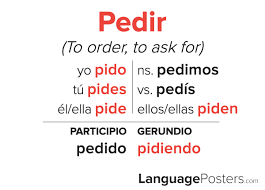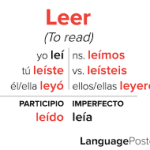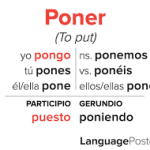Are you struggling with conjugating the verb ‘pedir’ in Spanish? Look no further! In this article, we’ll guide you through the different tenses and help you master this essential verb.
From the present tense to the conditional and subjunctive forms, we’ve got you covered. By the end, you’ll be confidently using ‘pedir’ in any conversation.
So, let’s dive in and unlock the secrets of conjugating ‘pedir’ in Spanish!
Present Tense Conjugation
To conjugate ‘pedir’ in the present tense, you’ll need to use the compound preposition ‘a’ followed by the appropriate pronoun. This is a common pattern in Spanish verb conjugation.
For example, when you want to say ‘I ask’ in Spanish, you’d say ‘yo pido.’ Here, ‘yo’ is the pronoun for ‘I’ and ‘pido’ is the conjugated form of ‘pedir’ in the present tense.
Similarly, if you want to say ‘you ask,’ you’d say ‘tú pides,’ where ‘tú’ represents ‘you’ and ‘pides’ is the correct conjugation.
Remember to use the appropriate pronoun with ‘pedir’ in the present tense to correctly express who’s doing the action of asking.
Preterite Tense Conjugation
Let’s now talk about the points you need to know about preterite tense conjugation in Spanish.
Firstly, regular verbs in the preterite tense follow specific endings depending on the subject pronoun.
Secondly, there are stem-changing verbs that undergo changes in the stem when conjugated in the preterite tense.
Lastly, there are irregular verbs that don’t follow the regular conjugation patterns and need to be memorized individually.
Regular Verb Endings
Conjugate ‘Pedir’ in the preterite tense by adding the appropriate verb endings.
To form the preterite tense of ‘pedir’ (to ask for), simply take the verb stem ‘ped-‘ and add the regular verb endings for the preterite tense.
For the second person singular (you), the ending is ‘-iste’. So, in the preterite tense, you’d say ‘pediste’, meaning ‘you asked for’.
To form the second person plural (you all), the ending is ‘-isteis’. Therefore, ‘pedisteis’ translates to ‘you all asked for’.
It’s important to note that in the preterite tense, the stem vowel ‘e’ changes to ‘i’ in the second and third person singular forms.
Stem-Changing Verbs
Now let’s explore how stem-changing verbs in the preterite tense affect the conjugation of ‘pedir’. In the preterite tense, stem-changing verbs undergo a change in the stem of the verb when conjugated. However, ‘pedir’ is an exception to this rule. It remains regular in the preterite tense, meaning that it doesn’t experience any stem changes.
So, when you conjugate ‘pedir’ in the preterite tense, you simply use the regular verb endings. For example:
- ‘pedí’ (I asked)
- ‘pediste’ (you asked)
- ‘pidió’ (he/she/it asked)
- ‘pedimos’ (we asked)
- ‘pedisteis’ (you all asked)
- ‘pidieron’ (they asked)
Irregular Conjugations
To conjugate ‘pedir’ in the preterite tense, you’ll need to use the regular verb endings, as discussed in the previous subtopic. However, it’s important to note that ‘pedir’ is an irregular verb, which means it doesn’t follow the usual pattern of conjugation.
In the preterite tense, the stem of ‘pedir’ changes from ‘ped-‘ to ‘pid-‘ for the second and third person singular forms. For example, instead of saying ‘yo pedí’ (I asked), you’d say ‘yo pedí’ (I asked). The rest of the conjugation remains the same, using the regular verb endings.
So, to conjugate ‘pedir’ in the preterite tense, you’d say ‘tú pediste’ (you asked), ‘él/ella/usted pidió’ (he/she/you asked), and so on.
Remember to practice these irregular conjugations to improve your Spanish skills.
Imperfect Tense Conjugation
First, learn how to conjugate ‘pedir’ in the imperfect tense. In the imperfect tense, the verb ‘pedir’ changes its stem to ‘pedí-‘ and adds the following endings: -ía, -ías, -ía, -íamos, -íais, and -ían.
For example, if you want to say ‘you used to ask’ in Spanish, you’d say ‘tú pedías’. Similarly, ‘we used to ask’ would be ‘nosotros pedíamos’.
The imperfect tense is used to talk about past actions that were ongoing, habitual, or repeated. It’s also used to describe background information or set the scene in a story.
Future Tense Conjugation
To conjugate ‘pedir’ in the future tense, use the stem ‘pedir-‘ and add the following endings:
-é, -ás, -á, -emos, -éis, and -án.
- You’ll use the future tense to talk about future actions or events related to the verb ‘pedir’.
- The future tense is formed by adding the appropriate ending to the stem of the verb.
- The endings for the verb ‘pedir’ in the future tense are: pediré, pedirás, pedirá, pediremos, pediréis, and pedirán.
For example, if you want to say ‘You will ask for a favor,’ you’d say ‘Pedirás un favor.’ In this sentence, the verb ‘pedirás’ is conjugated in the future tense to match the second person singular pronoun ‘you’.
Remember to apply these endings to the stem ‘pedir-‘ to correctly conjugate ‘pedir’ in the future tense.
Conditional Tense Conjugation
To form the conditional tense of ‘pedir’, you take the infinitive form ‘pedir’ and add the appropriate endings. For the second person singular pronoun ‘tú’, the conditional conjugation of ‘pedir’ is ‘pedirías’. This means ‘you would ask’ or ‘you would request’.
For example, if you were to say, ‘Si yo fuera tú, pedirías ayuda’, it would mean ‘If I were you, you’d ask for help’. Remember to add the accent mark on the letter ‘i’ in the second and third person singular forms.
The conditional tense is used to express hypothetical situations, polite requests, or suggestions. Now you know how to conjugate ‘pedir’ in the conditional tense in Spanish.
Present Subjunctive Tense Conjugation
Let’s talk about the common irregularities you may encounter when conjugating ‘pedir’ in the present subjunctive tense.
These irregularities occur in the stem of the verb and affect the endings.
For example, instead of ‘pidas’, you’d say ‘pida’.
Understanding these irregularities will help you form correct sentences in Spanish.
Common Irregularities Explained
You should be aware of some common irregularities when conjugating ‘pedir’ in the present subjunctive tense. Here are three important points to remember:
- Stem change: In the present subjunctive, the stem of ‘pedir’ changes from ‘p’ to ‘pid’. Therefore, the conjugation becomes ‘pidas’ instead of ‘pides’.
- Spelling change: When the subject pronoun ‘yo’ is used with ‘pedir’ in the present subjunctive, the spelling changes to ‘pida’. So instead of saying ‘yo pido’, you’d say ‘que yo pida’.
- Accent mark: In the third person singular and third person plural, an accent mark is added to the letter ‘i’ in ‘pedir’. This means that ‘él pida’ becomes ‘que él pida’, and ‘ellos pidan’ becomes ‘que ellos pidan’.
Remember these irregularities to correctly conjugate ‘pedir’ in the present subjunctive tense.
Examples of Usage
Continuing from the previous subtopic, it’s important to understand the examples of usage for the present subjunctive tense conjugation of ‘pedir’ in Spanish.
When using the present subjunctive tense, you’d say ‘que tú pidas’ to express the desire or request for someone else to ask for something. For example, ‘Espero que tú pidas ayuda’ translates to ‘I hope you ask for help.’
Another example is ‘Es necesario que tú pidas permiso’ which means ‘It’s necessary for you to ask for permission.’ In both cases, the verb ‘pedir’ is conjugated to match the subject.
Imperfect Subjunctive Tense Conjugation
To conjugate ‘pedir’ in the imperfect subjunctive tense, start with the preposition ‘que’ followed by the contracted form of ‘tú’ and the appropriate verb ending. Here is a step-by-step guide to help you understand the conjugation process:
- Start with the present tense ‘tú’ form of ‘pedir’, which is ‘pides’.
- Remove the ‘-es’ ending to get the stem ‘pid-‘
- Add the appropriate imperfect subjunctive ending to the stem:
- For ‘-ar’ verbs like ‘pedir’, add ‘-ieras’ or ‘-ías’ for the ‘tú’ form.
- For example, ‘pidieras’ or ‘pidías’.
Affirmative Imperative Conjugation
To conjugate ‘pedir’ in the affirmative imperative form for the second person singular, simply use the contracted form ‘pide’. This form is used when giving commands or making requests to someone you’re familiar with.
For example, if you want to tell someone to ask for something, you’d say ‘Pide’ followed by the thing they should ask for. For instance, ‘Pide ayuda’ means ‘Ask for help.’
It’s important to note that in this form, the pronoun ‘tú’ is omitted because it’s implied by the verb ending. So instead of saying ‘Tú pide’ you’d simply say ‘Pide.’
Remember to use this form when you want to give a direct command to someone in the second person singular.
Negative Imperative Conjugation
To conjugate ‘pedir’ in the negative imperative form for the second person singular, don’t use the contracted form ‘pide’. Instead, follow these guidelines:
- Start with the word ‘no’ (meaning ‘do not’) before the verb ‘pidas’.
- Drop the final ‘s’ from the verb ‘pidas’ to form ‘pida’.
- Add the word ‘tú’ after ‘pida’ to indicate the second person singular subject.
So, to say ‘Don’t ask’ in Spanish, you’d say ‘No pidas tú’.
This form is used when giving a command or order in a negative way. For example, if you want to tell someone ‘Don’t ask me any more questions’, you’d say ‘No me pidas más preguntas’.
Remember to use this form when you want to give a negative imperative command using the verb ‘pedir’.
Frequently Asked Questions
What Is the Meaning of the Verb ‘Pedir’ in English?
When you ask what ‘pedir’ means in English, it translates to ‘to ask’ or ‘to request.’ Now, let’s dig into the conjugation of ‘pedir’ in Spanish.
Are There Any Irregularities in the Conjugation of ‘Pedir’?
There are irregularities in the conjugation of ‘pedir’ in Spanish. In the present tense, the second person singular form is ‘pides’. However, we will discuss the specific conjugations in the context of ‘pedir’ in Spanish.
Can You Provide Examples of Sentences Using ‘Pedir’ in Different Tenses?
Sure, I can provide examples of sentences using ‘pedir’ in different tenses. Whether it’s present, past, or future tense, I’ll show you how to conjugate and use ‘pedir’ correctly.
How Do You Form the Gerund of ‘Pedir’?
To form the gerund of ‘pedir’ in Spanish, you drop the -ir ending and add -iendo. So, the gerund form of ‘pedir’ is ‘pidiendo’. Remember to use this form when talking about ongoing actions.
Are There Any Special Rules or Exceptions When Using ‘Pedir’ in the Subjunctive Mood?
When using ‘pedir’ in the subjunctive mood, there are no special rules or exceptions. Just conjugate it like any other regular verb in the subjunctive form.
Conclusion
In conclusion, conjugating the verb ‘pedir’ in Spanish involves changing the verb endings based on the tense and mood. These include:
- Present
- Preterite
- Imperfect
- Future
- Conditional
- Present subjunctive
- Imperfect subjunctive
- Affirmative imperative
- Negative imperative
By understanding the different conjugations, one can effectively communicate their requests and desires in Spanish. Practice and familiarity with these conjugations will greatly enhance one’s ability to speak and understand the language.


